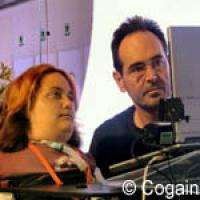An affordable future for eye tracking in sight

An ambitious five-year project will attempt to make eye-tracking technologies more affordable for people with disabilities and extend the potential use of the devices to enable users to live more independently.
The Communication by Gaze Interaction (COGAIN) project will examine current state-of-the-art technologies, develop new software standards to extend the available products and research new applications for the technology based on end-users' real needs.
"It's a big project and it's novel in that it brings together all the interested parties," says Kari-Jouko Räihä, Professor of Computer Science at the Finnish University of Tampere and IST-funded COGAIN project coordinator.
It's also important. Eye tracking technologies could transform the lives of tens of thousands of people across Europe. The most extreme example of how this technology is used is its ability to give voice to people who are 'locked-in', people who can only move their eyes and only communicate with their gaze, says Räihä. "But it also has applications for people with Amyotrophic Lateral Sclerosis [ALS], also known as Lou Gehrig's disease, or Cerebral Palsy, or Multiple Sclerosis [MS]."
Currently state-of-the-art eye tracking equipment is very advanced, with an extremely high spatial and temporal resolution – it can detect tiny movements in millisecond intervals. "The problem is that this equipment is very expensive – about €20,000 for a top-of-the-range system," says Räihä. COGAIN hopes to develop new equipment – in cooperation with manufacturers – that can provide sufficient resolution at a reasonable cost.
The basic eye-tracking system consists of a camera, a computer and software to provide an interface between the two. In an expensive system the camera uses an internal light source to create reflections on the eye. The camera tracks these reflections and uses them to move a cursor on the screen, for example. COGAIN hopes to provide the same functionality, though at a lower performance, using an ordinary Web cam and ambient light.
But the project plans to do more. Currently eye-tracking systems are tied to proprietary software, which means that every new application must be written for a particular piece of controlling software. COGAIN wants to create standard control software so applications can be developed by anybody.
This is a key development. One of COGAIN's aims is to develop new applications. This could include new types of text entry. "Currently most text entry is done using a 'soft keyboard'. Essentially it's a picture of a keyboard and users move the cursor along until they find the right letter," says Räihä.
But another system developed by one project partner, the University of Cambridge, uses a type of predictive text, where letters move across the screen and users fix their gaze on the letters they want. "It's an unusual system, and it takes a little training to get used to it, but users can enter text at 20 words a minute once they become familiar with the system. That's very fast," says Räihä.
He adds that the application is hard to imagine if you don't see it in action. "But think of all the other potential applications for this technology that we just haven't thought about, or imagined yet. The potential is enormous and COGAIN aims to develop that."
The project's partners already have some ideas. Software that could control heating and lighting through eye-tracking technology and a PC is one possible application. "We currently have a specialist group within the project looking at environmental controls," says Räihä. He adds that they are also examining the potential for controlling a wheelchair through eye-movements. This could change lives, for the better.
The project began in September 2004 and the team spent the first year establishing the current state of the market and creating links between all the different stakeholders. "So far we've held several meetings to build up networking between the various partners in the consortium," says Räihä. "We've also held our first COGAIN camp, which brought researchers and manufacturers into contact with end-users. It was a very interesting meeting and the researchers gained a new respect and understanding for the needs of people with disabilities."
Source: IST Results















